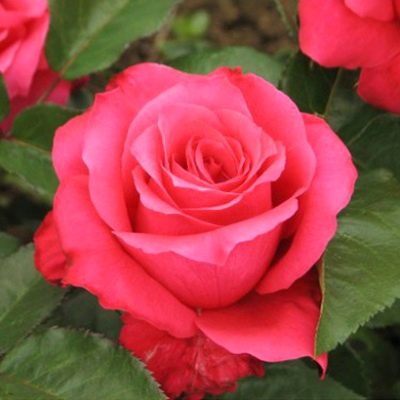
- Authors: Stanislaw Zyla
- Name synonyms: Venrosa, Visockiy, Venroza
- Breeding year: 1980
- Group: tea-hybrid
- The main color of the flower: raspberry
- Flower shape: from classic hybrid tea to open cupped at different periods of the flower's life
- Flower size: large
- Diameter, cm: 12-13
- Flower type by number of petals: medium terry
- Scent: unusual, pleasant
Rose of Vysotsky came to us from Poland for a very long time. Today this beautiful flower can be found in many regions of our country. To achieve abundant flowering from him, it is enough to provide proper care and attention.
Description of the variety
The year of breeding for Vysotsky's rose is considered to be 1980. The variety belongs to the hybrid tea species. It is widely grown for cut, because amazing bouquets are obtained from flowers.
Vysotsky's rose has a crimson-pink shade of buds, and the main color of the flowers is crimson. A very rich variety with a round shape of buds. Flowers can be of different shapes: from classic to cupped, depending on the period of the flower's life.
Roses are formed on bushes large, some of them reach 13 cm in diameter. Vysotsky's rose belongs to medium-sized varieties with 40 petals in a bud. More often, one flower per inflorescence is formed on a bush, very rarely there are several. The described rose variety is also appreciated for its pleasant, very unusual aroma, which is distinguished by its intensity.
Vysotsky's rose bushes grow tall, with a dense crown. Erect shoots, foliage can be described as good. The color of the leaves is dark green, the foliage grows large in size, so timely pruning is so important for Vysotsky's rose.
Advantages and disadvantages
Strong aroma, large flowers, unique decorative qualities and especially shade - all these are some of the main advantages of this variety.
Among the shortcomings, one can note the need to constantly cut off the bushes and thin them out so that moisture does not stagnate in the leaves. Also, the variety is sensitive to rain.
Flowering features
Vysotsky's rose blooms from June and continues to delight with its beauty until autumn. Refers to multi-flowering varieties.
Use in landscape design
Vysotsky's rose has a wide range of applications in landscape design: while some gardeners grow a flower exclusively for bouquets, others create hedges, arches from bushes and decorate gazebos with them. The variety looks good both in single plantings and in rose gardens.
Landing
In order for the Vysotsky rose to show what it is capable of, it is better to plant it in a sunny place where there is no draft. The soil for it should be not only well-drained, but also densely fertilized. It is best to prepare the place in the fall, add a large amount of humus or compost and dig everything up. The soil for Vysotsky's rose should be with a pH of 5.6-7.3. In the spring, planting roses in open ground should be started in early May.
Before immersing the bush in the planting hole, you should make sure that its size is sufficient for the existing root system. The roots can be trimmed slightly and straightened along the bottom. Drainage is laid on the bottom, then a layer of fertile soil. Vysotsky's rose is covered with earth to the root collar, the soil is crushed to remove air pockets.
Growing and care
High humidity is harmful to Vysotsky's bushes, therefore, dense plantings should not be created, since they impede ventilation.The leaves of this variety must dry quickly after rain, otherwise fungal diseases cannot be avoided. If the bushes of Vysotsky's roses will be planted in the fall, then the first top dressing is applied at the end of March, and the second in June. Spring seedlings are fertilized with high quality in summer.
When planting, care must be taken not to plant Vysotsky's Rose too deep or, on the contrary, shallow. On heavy soils, the place of the root collar, from which the shoots grow, should be 2-3 cm below the ground. If the flower is planted in light sandy soil, then the root collar should be located 5 cm below the surface of the soil.
To prevent the root system from freezing, you can bury the bushes with soil 20 cm.
Watering and feeding
Watering Vysotsky's rose is required abundantly, but no more than once a week. Watering is carried out exclusively at the root. The best time is morning. After that, the trunk circle can be covered with a thick layer of mulch.
Top dressing is carried out in the spring, you can still give complex mineral fertilizers in the middle of summer, a slow-release fertilizer would be a good option. In autumn, the bushes are not given nitrogen, since it will provoke the growth of new shoots, and they can freeze in winter.
Pruning
The first pruning of Vysotsky's rose bushes is carried out immediately before planting. The ends of the stems are cut by 3-4 cm. In the summer, faded flowers are constantly removed. In addition, the Vysotsky rose is pruned in the spring. Such sanitary cleaning helps to put the bushes in order, remove old, diseased shoots, thin the crown.
Frost resistance and preparation for winter
For the winter, this variety must be covered, especially if these are young plantings. The frost resistance of Vysotsky's rose is above average, it can withstand no more than -23 degrees.
Diseases and pests
The immunity of the described variety is also above average, therefore, treatment with fungicides and insecticides is considered necessary.
For aphids and other insects, you can use folk remedies, for example, an infusion of garlic or neem oil. Commercial insecticides are also commercially available; dilution is required in accordance with the instructions on the package.































































